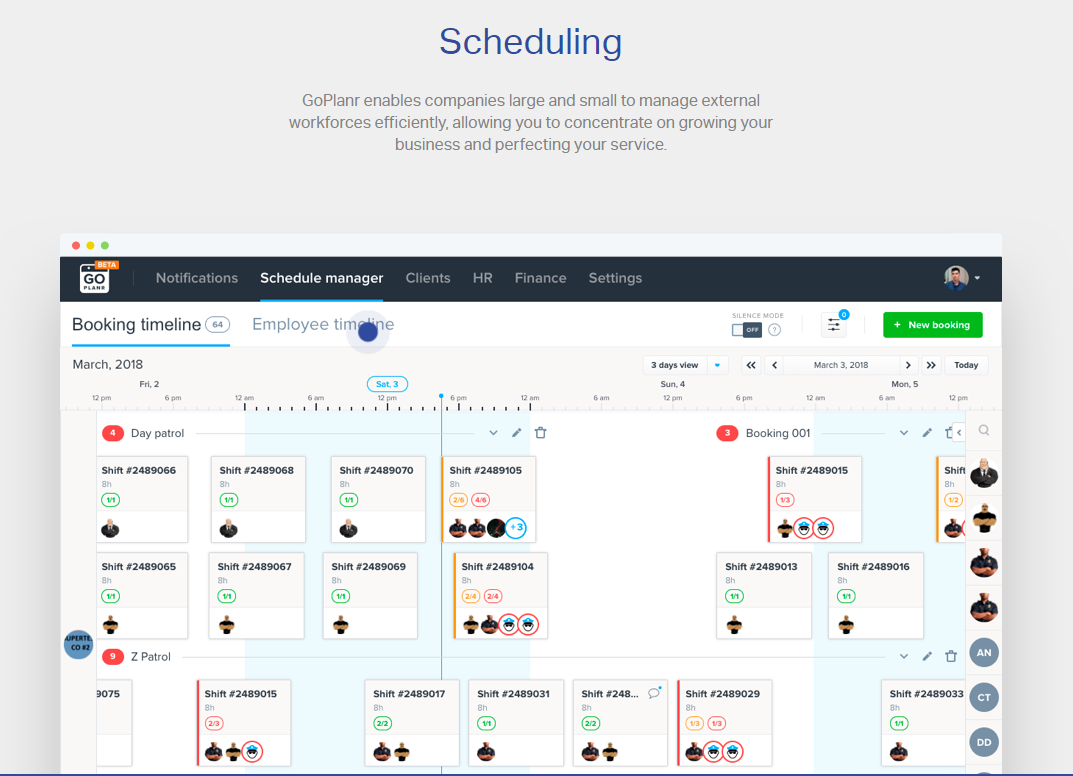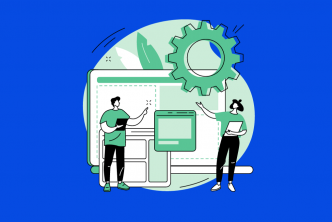A must-read for aspiring Product Owners and Product Managers
Transcribed from an in-person interview with Valon at his offices in London, March 2018
I’m here with the founder of GoPlanr, Valon Statovci and we are discussing the development of the ‘whole product’ and what this means for this stage of the business.
Tristan: Valon, how did you come up with the idea for GoPlanr?
Valon: The idea of GoPlanr came from experiencing problems with organizing security operations, particularly those involving large external workforces.
We found it was difficult to grow using the existing system, which was manual. We literally used Google Sheets to manage where our staff was working and the timing of their shifts. As the number of staff grew we faced huge problems with managing them.
I started to look for solutions online and it took quite a while, I’d say several years actually. I tried a few online tools and they all were rubbish. I had a very clear idea of what the software should do and how. We came to the conclusion that we should try to develop it ourselves. And that’s how the idea of GoPlanr came about. It was originally called Shiftplanr.
Insight #1: Identify a true market need
Valon: The initial idea was to build something that worked for us as a security company than to regain the investment expenditure back and then market it as a separate Product Company. The potential of commercializing the product has increased, becoming more clear and apparent. Now, we want to focus on really growing it as a product business.
Tristan: Yes, I think that’s one of the points of difference about your story vs other Product Owners I’ve come into contact with. You’ve gone through the process of using the product internally, taking the time to flush the bugs out and to really demonstrate the product before going out to the market to commercialize it.
Most Product Owners are seeking to go straight to the market. In many cases, it’s stronger to go the less direct route.
What has been your experience using GoPlanr so far?
Valon: We’ve been using GoPlanr since January 2017, already having an MVP at that time. The thing is that, as soon as you start loading real data to the platform that’s when problems occur. You can do all the QA you want with fake data but when you load real data something will come up. And that is what happened, as every month there were problems. Luckily it was all internal and we were prepared for that to happen, we had contingencies in place and were able to absorb those problems.
If we went to the market and had to pay customers we wouldn’t have everything working correctly and could even lose the customers. After another 6 months, the product was stable, there were no issues and we only had to improve every feature in detail.
Insight #2: Find the least risky path to market
Valon: One of the companies testing GoPlanr emphasized that they could see that the software had been built by people who truly know the industry, because of small details, specific to our industry. Companies developing standard scheduling software wouldn’t build specific features with such care because they are not important for generic usage.
However, for our industry (management of external workforces of security guards) something really small can have a huge impact on the time efficiency of Security Management Operations.
For instance, we put in place that you can set an unpaid break, allowing the user to decide whether they want to charge the client for the break or not. We had situations where clients didn’t want to pay for breaks, we tried to negotiate but unfortunately were unsuccessful. Still, we don’t feel it is fair to dock pay from the employee, so we decided not to charge the client for that 30 minutes break. This is a minor detail but we do still have to pay the employee for that time.
This issue is not common but it is nice to know that you don’t have to manually work out the changes to hours your staff worked. Sounds like a small feature, but if you have a lot of employees it can be really time-consuming, so it is convenient to have this automated instead of assigning this work to a full-time employee.
Insight #3: Commit to an initial Target Market of only one segment & use case
Tristan: Please describe how the product differs from standard scheduling software?
Valon: The main thing is the timeline. The one we have designed is completely unique. Timelines in traditional scheduling software seem to be a copy & paste from each other and they are pretty static. What we’ve built is a more fluid timeline.

There are boxes that represent the shift but they can have as many people inside as you may need, two or more people for the shift. Other software requires separate boxes for each and every individual when we have just one.
The width of the shift is identical to its duration, depicting:
- When shifts are starting,
- How long they are going to be on; and
- How they relate to the whole time period in real-time.
Visually you can see where the shifts are and what needs to be done so you get all the information straight away without needing to dig deeper.
Tristan: I guess another point of difference is that multi-site and multi-client approach. Can you touch on this?
Valon: Yes, it is. Scheduling software usually allows multi-site, multi-location to a certain degree as this is what it is designed for. The way we do it is different – we allow the users to see everything at once if they want: you can see all clients or filter them, also filter by location. That’s where we differ.
With the other software, you have schedules for each site, within which you can manage and publish shifts, but because it is not live and you need to constantly switch between sites. Our product is live, you don’t need to publish anything. What we do is shared with everyone in the Operations Management team, so you can view everything at once if you want.
Tristan: From what I’ve seen you can have multiple people working on this in real-time?
Valon: It is a multi-user real-time system. When you have to click “refresh” constantly to check for updates, that is not a real-time system. So that is where the difference is, our system is ‘real’ real-time and multi-user. We based it on how Google works if you share a document you can see what has been edited and at the same time you can see who is editing and what is being edited. It makes collaborate a lot easier.
So that is where the difference is, our system is ‘real’ real-time and multi-user.
Insight #4: Select a feature set to differentiate yourself from Mainstream Competitors, whose software products have generic use cases
Tristan: What sort of activities, did you do at the very start of the Product Development Process?
Valon: The benefit we had was being the creator and the customer at the same time, so we were able to brainstorm everything we, as the customer:
- Wanted to achieve,
- What’s important for us, and;
- Where we wanted to improve the efficiency of the business so we could reduce costs and grow.
The first thing we did was: we sat down and thought about what activities within our business take a long time and a lot of resources to fulfill and what aspects of the job are the most difficult. Once you identify those problems, it is much easier to look for the solutions. That’s how we build features. If we had a particular set of problems, it is almost guaranteed that most agencies will face similar problems. And that’s how we came up with a product that exceeds our expectations.
If we had a particular set of problems, it is almost guaranteed that most agencies will face similar problems.
Tristan: Yes, so you sort of identified bottlenecks in the organization and you sought, at that time, the most simple solutions to those problems from a technical standpoint. That’s excellent.
Insight #5: Make sure you have a domain expert on the Product Ownership team, so you understand the problems you are solving & their implications
Valon: I went into a lot of detail with it. Working with Andrew and Kate I realized it is important to provide as much information as possible to get a good product back.
A lot of people think that if you speak to the tech professionals, describe your idea to them, they should know how to implement it. But it is not the case because you are the one who should know how to do it and they just help you to achieve your Product Vision.
I sought to provide as much information as I could, I went to the extreme of doing a huge chart explaining how the product works in detail.
Tristan: So you created a HUGE wireframe?
Valon: Yes, a full wireframe, it was gigantic and very detailed. I believe it helped in building the groundwork for MVP.
Tristan: It reminds me of what I did with my first SaaS project back in 2012. I had a spreadsheet which actually had buttons and comments, I’ll have to show it to you.
A lot of people think they can skip this process of doing things like MVP maps, wireframing, high-level user stories etc. Just because you know what you’re doing, doesn’t mean the developer understands all of the context.
Valon: I’ve learned very quickly that you have to give even more detail than you think is needed.
Insight #6: Create high-quality product documentation, with specific instructions, before commencing with development activities
Valon: Maybe that’s because of the different types of mindset. Let’s say if you are creating a product you naturally adopt a creative mindset, while your developer might have more of a logical mindset.
You can’t expect developers to perceive your vision in the exact same way as you do. That’s why it is important to structure everything so a person with a logical mind can understand where you want the product to go.
Insight #7: Use your product documentation to communicate your Product Vision to the whole team of Designers and Developers
Tristan: I expect you also went through quite a rigorous UX process?
Valon: Yes, well I mean, I laid the groundwork for that and then YouTeam (acting in a Product Management role, at that time) in collaboration with the design studio helped with the UX. They did a really good job.
I had quite a clear image of how the timeline should work and they stuck to it, but what was really impressive is that they’ve improved it massively. I had the idea of how this should look and they came up with something that looked completely different, still having the same characteristics I needed but the information was portrayed a lot more nicely. UX was 10 times above what I originally thought it could look like. That’s what you pay for I guess.
Tristan: Yes, there is definitely a huge amount of value that’s added in the UX phase.
We’ve noted that there were a few differences to how you expected the product vision stage to occur. Was there anything else that jumped out at you, besides the need to create product documentation, before you start development and to go through the UX / wireframing process?
Insight #8: Engage a really experienced UX engineer, they can add huge amounts of value to your Product very quickly
Valon: I suppose it would be the need to constantly repeat the vision of what each part of the product is and why it is needed. It happens often when I have a feature to add and the project manager recommends leaving it until later because it doesn’t seem that important. The truth is that no one apart from you truly understands the full picture, because it is in your head, so you have to constantly repeat it to get the vision and message of why certain things are important and why we want to build this first. It is very hands-on, extremely hands-on apart from the coding for sure.
Tristan: Well yes, by the coding stage you know what you are doing or should do.
Another thing I’d mention about the benefits of creating a comprehensive package of Product Vision documentation is that it really helps you in onboarding new people onto your team. You need to be able to provide them with a set of documents including wireframes, user stories, MVP maps, etc. People shuffle in and out of projects over the course of the time. GoPlanr, in fact, has been going for 2.5 years now.
Insight #9: Be prepared to stand up for and reinforce your Product Vision, throughout the lifecycle of the Product Development process
Valon: Time is another thing. I’ve learned that you can never really set a timeframe for development projects. When we were just starting, I wanted to know what the timeframe was. However product development is very much like art – a process where it is guaranteed that you will want to change things constantly, hence the timeframes can be huge. It also depends on the budget you are willing to spend, the more people you get involved the quicker you get the product. But I even doubt that could help much, because you can have all people in the world but you need to manage them and there is only a certain efficiency ratio.
Tristan: It sort of logarithmic as well, that is, adding more people to the team is not linearly proportional to progress with the product. The bigger the team, the more communication effort is required.
Insight #10: Patience is a virtue in Product Development, the process has a terminal velocity
Extending the GoPlanr Product Development team, with the help of YouTeam
Tristan: Let’s talk about when it came time to extend the team.
To start off with the first person that you were involved with was Andrew (Product Manager) and then Kate (IT Project Manager) had some involvement.
What was the order of people that joined the Product Development team thereafter?
Valon: Andrew helped to build a scope to try and give me some kind of timeframes and cost estimation. Part of that was then being presented to software development studios, which helped further elaborate our Product Vision.
I was introduced to Kate from dev shop, and then to the design studio, and a QA studio.
There were 3 different companies and I was convinced by Andrew that those were the best companies, at that time, to work at the project. There were other solutions and companies as well but it worked out with those we’ve chosen.
I also went and met with the teams and I see this as an incredibly important part of the process. When you meet in person it is very different from a Skype call, because the message can be received more clearly, because body language is involved and everyone is better synced.
Tristan: One of the key roles of the Product Manager is to define the overall vision of the product and to maintain the product vision throughout development, so that’s why this role is so important. So we’ve talked about the chosen partners for design and development and then you also had a QA studio as well. Who were they?
Valon: I can’t remember the name because what happened is that person left the company and was replaced by Alexey who eventually started his own studio and we moved on with him as he knows the product inside out and it makes a big difference.
Managing a team, which fluctuates in size over the course of time
Tristan: How did the team fluctuate over time?
Valon: It started off with one developer because it was mostly design work and front-end development. You can’t really put an exact figure because there were a lot of people involved at every stage.
Our development company liaised with the designer studio and had teams that did front-end, architecture, and back-end. So in the beginning, it was hard to say how many people were actually involved because there were different teams working on different things to build the foundations.
Then we stabilized on having 2 full-time developers, Kate as a full-time project manager, the studio doing the design work, and the QA being done independently.
Last summer we increased the number of developers to 3, the design studio from Lviv is no longer involved as they felt the distance between designers (Lviv) and developers (Kyiv) was too large. But at that time the main design work was already done, so I agreed to the design work being done inside of our development company.
The most value contributor to GoPlanr
Tristan: Other than yourself as Product Owner who would you say was the most valuable contributor to GoPlanr?
Valon: Kate. She is the best project manager I’ve worked with. She comes across as if it is the only project she does and it is not because I’ve seen some of her other projects. She really took ownership of the concept and believes in it.
In fact, I think she believes in its success more than even I do. She really helped to drive everything. She is very dedicated as you can get messages from her at 12 at night when it is 3 am in Kyiv as she had some thoughts or information to share. Alexey has shown himself in the same way. He could respond even in the middle of the night or during the weekend.
Tristan: I guess that for the team to know they are on a project that has a lot of potential and is heading in the right direction is extremely motivating.
YouTeam’s role on the project as Product Managers and those who facilitated team extension
Tristan: Why did you choose YouTeam as a collaborator?
Valon: As a security management company we’ve not done any development work in the past. When it came to IT I wanted someone I could trust.
YouTeam was based in London at that time so I was able to meet Andrew and Anton and that actually eased the fear of outsourcing. Development in London was and still is extremely expensive compared to outsourcing. And that’s not to say you get better quality.
I’ve found that in Eastern Europe you can find a lot of talent for a very reasonable price but it was the fact that I could meet them face-to-face and have a company I could go to if something went wrong. If I was to outsource fully just to Ukraine and something didn’t work out, there would be no one who I could turn to. So having YouTeam in the middle is almost like an insurance policy.
Expert Tip #11: Manage the risk of outsourcing by collaborating with an intermediary, domiciled in the UK or the US (for example) so there is accountability
Tristan: Excellent. Where there any more benefits?
Valon: Price obviously. It was a massive factor. I mean price was the factor, but if they were not here in person I wouldn’t trust it.
Tristan: You wouldn’t trust the pricing because it was so different from the London pricing?
Valon: Yes, it was important to meet them. To go to Ukraine and meet the people who were to work on the project. I needed to see that it is a real company and they have other projects because on the Internet everything can be presented very nicely but might not exactly match the reality. For me, it is important to meet the people because it is a long term project and a lot of money invested.
Tristan: Even now that YouTeam presents as more of a recruitment platform, their (& my) big suggestion is that the founders and the Product Owner go to meet their team, not only the business development manager.
Insight #12: Minimise your outgoings on MVP development by outsourcing intelligently, do your due diligence by meeting the team
What are the most important insights, challenges, or even lessons learned during your GoPlanr journey so far as a Product Owner?
Valon: It is way more work intense from my side than I thought it would be. It is a good thing, it really gets you to love what you do. That’s the nice thing I’ve learned. Another thing is that you are launching a product and a business from scratch.
Tristan: A lot of people forget that actually and that is the key point when they build an app they think about the technology but don’t think about the company that needs to be created to sit behind it.
Insight #12: Recognise that you are not just creating a Product, you are creating a Product Company, don’t forget to pay attention to the Business-side
Valon: Yes, that’s true. I‘ve built companies before, this is the first one that is online based so there are different things you need to focus on. Then you have to start thinking about the funding of the project because it is very easy to fall into treating it as a toy and spend whatever needed just to grow it. That is not how it should work, and I’m now changing my thinking to considering it as a business that it has to be self-sufficient, it needs to be successful on its own merit, not being propped up.
We have gone through the phase of building an amazing product and now we need to build an amazing business. Before I would say that for example, I need these 20 features built because it is good for my existing security company, but now the question is what is good for the new business (GoPlanr Product Company). It is important to treat it is as a business not as a toy project as it is really easy to fall into it and it is important to change that mentality.
Insight #13: Once the product is developed, the focus needs to shift from Product Development to Product Marketing
Tristan: Yes, that’s right. Kate has been sending us some articles about how to decide between different features you can choose to push. From now on the features should be selected on the basis of the commercial value they create for your new clients. And obviously, you should broaden the scope of what you are doing at GoPlanr to start to include the marketing, sales, and customer success and all the other functions that are required as part of the product company.
Where are you up to in the process of product development of GoPlanr?
Valon: Pretty close to the end. The scary end where we have to start selling the product. We are at the point when we have external companies testing our platform, which is important because we get a view of whether is it a solution for them. Because as I’ve said earlier it is a solution for us and we need to know if it is suitable for others. If it doesn’t, then we’ve built a lovely shiny toy.
It is a way of validating what we’ve built, to make sure we are not going to launch the product and embarrass ourselves. We need to get some kind of case study that shows that our product will work and will help other companies to increase their efficiency.
Tristan: In terms of the business itself what are your immediate plans? What are the next steps?
Valon: To make sure that I no longer treat it as a vanity project, as an internal project and instead treat it as a business. So it has to become self-sufficient very quickly.
I intend to continue the development and growth of the actual product, to ensure that we are giving ongoing value to our clients. We want to have a subscription model and if we do there is a requirement to continuously improve the product. We need to be able to have a support structure for our clients to provide the rapid resolution of any issues we may encounter.
Tristan: So it is all about delivering value to the customer through the product as an online portal and all the other supporting activities?
Valon: Yes, supporting activities. You are selling the product and online services around that product as well. We are talking about support, training, things like that. You need to provide documentation, and the customer needs to learn how to use it.
Expert Tip #14: Once the ‘generic product’ is developed, you need to create the rest of the operations and marketing infrastructure that service the Product Company. You need to create the ‘Whole Product’
Tristan: Best of luck for the future of GoPlanr & congratulations on getting this far.

GoPlanr is a dedicated solution for workplace agencies who need to deploy employees to multiple client sites.






